July 2003
1st July
First of all, a close-up of the Angle Shades moth.
I've walked this hedgerow for 5 years, now and this is the first time I've noticed the only Holly specimen.
The Hardheads will show flowers like thistles, soon
2nd July
Nothing, today: The hedgerow was a detour for a main road with a broken water main, and was far too busy for safety. So I've worked on a Map page, to set the Hedgerow in context, and added some new items to the Annexe.
3rd July
Over the course of the next 3 weeks, access to the hedgerow will essentially be outside working hours - the diversion will last that long. So expect the Annexe to be busy, and for images on this page to to flared due to flash (late evening access).
First, the Yarrow - notice the very finely notched leaves:
And now another tree - the Ash...a very common tree, here, easily identified by its pale grey bark.
The Sorrel has set seed, now - an attractive shade of pink.
Three Grasses, from left to right, Yorkshire Fog, False Oat, Cock's Foot :-
5th July
All today's action was in a boggy area on a hilly, deforested hilltop.
So go to the Annexe (It's worth the visit!).
6th July
Back to the Hedgerow, today, but the Annexe also got some attention.
The Bindweed, or Convolvulus, climbs around other plants for
support:
It sometimes twists itself round the stems of its own previous years growth, making rope-like structures, leading to its other name of Ropeweed.
I was very surprised to see Raspberries fruiting so early.
The
Honeysuckle has been out for a little while. I used to suck the nectar in my
youth.
7th July
This
is a Plume Moth. Thanks to Hans for the ID on this and a number of others.
This is the Wild or Wood Angelica, and will have a large umbrella of white or pinkish flowers.
The Hawthorn fruits (called Haws) are showing, now:
8th July
This Dragonfly larva was changing puddles as we passed:
The beast was about 2.5" long. You can see my reflection in the 3rd abdominal segment.
9th July
This mushroom was about 1/2" tall on a long, thin stem. Looks like an Ink Cap.
Two more grasses:...Crested Dog's Tail on the left, and Ryegrass on the right:
10th July
Two more fungi:- The one on the left is tiny. To give some idea of size, the Procumbent Pearlwort flower to the left of it is only 3mm across. The set on the right were 1 to 2 cm across.
There was also a little work on the Annexe
11th July
Is this an invasion of privacy? The flower, by the way, is Hogweed.
And here's a close-up of the Bush Vetch flower:
12th July
Three insects, today:
This Meadow Brown can be identified by the single white dot in the wingtip.
The Frog
Hopper is the end result of the Cuckoo Spit. Here it's on Angelica.
This is a Large Red Damselfly, male I think. Smaller than the Dragonfly, this one was about 2" long.
The Annexe was updated, too
13th July
I've been trying to get the Ringlet to open its wings when resting for about 4 weeks, now. Tonight it did.
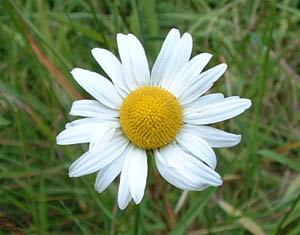
It turns out I do have the Ox-Eye on the Hedgerow. This one was facing the evening sun, so I suspected I'd get a good flashless shot. The flower head is 2 1/2 inches across.
I think I'll have to open a separate Willowherb page on the site. I started off the year thinking there were 3 species. It now looks as though I have at least 8.
This is the Rosebay Willowherb.
14th July
And this is the Greater Willowherb. It's about 4' high and has
been visible for about 2 months. Today it flowered.
15th July
The Brambles have started to appear. Looks like an early crop,
this year.
The
Tutsan berries have started to form. This plant continues to be attractive
throughout all its stages. I'll show it again when the berries turn black.
The flowering
shoots of the Ivy have leaves that don't look at all Ivy-like.
This little mushroom was only about 1/2" across.
This very large Caterpillar of the Northern Eggar Moth was crossing the path in front of us. It was about 3" long.
16th July
This
Sawfly has
a very bright green abdomen which can just be seen under the left wing
The seeds of the Ash tree are obvious, now
This is the same Angelica plant that I showed 9 days ago. It has grown 3' since then.
And
finally, today, the Knotgrass. The flower on the right is about 3mm across.
17th July
Interesting plant, tonight - the New Zealand Willowherb. The mass of curves above the flower is many seed pods.
.
18th July
Torrential downpour, today. Here's a shot of hedge, showing Tufted Vetch, Meadow Vetchling, Mares Tail, grasses and Angelica in the background.
19th July
Two very similar flowers, today:
On the left, the Lesser Burdock (been in bud for 6 weeks). On the right, the Hardhead.
I've always hated wasps since I was stung by one when I was a year old. This one's on a Bramble flower.(and you can see a spot of Bramble Rust on the leaf, too)
The Snowberry has started to form.
20th July
Here's a better example of the Red Admiral butterfly.
This
Woundwort has the broad leaves of the Hedge Woundwort, but is the colour of the
Marsh Woundwort. Both are close by so this is probably the hybrid.
It's a long time since I've seen the yellow Raspberry. I think they're sweeter than the usual red ones.
This is this year's Reedmace. There is a field full of them at one part of the Hedgerow.
21st July
These
Cinnabar caterpillars had completely destroyed the plant they were feeding on..
They usually feed on Ragwort, but it's hard to tell.
Here's a nice black slug - the weather was humid, so there were many of them out foraging.
22nd July
The Rosebay Willowherb is a very common plant, but if you look closely, you can see that it's also very beautiful.
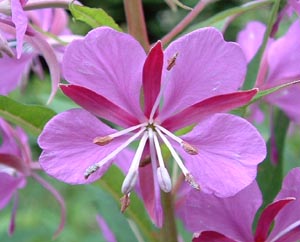
Another black beetle crossed our path.
And this is a close-up of the Cat's Ear:
23rd July
The Woody Nightshade is a member of the Solanum family. The red berries are poisonous.
24th July
Very heavy rain, today, but I did manage to get the Common Rush (left) and the Sharp-Flowered Rush.
I also added a new map to the map page
25th July
This has been one of my favourite flowers since it grew all over my uncle's vegetable patch.
The Hedge Bindweed or Convolvulus:
And now two seed heads:..on the left the Prickly Sow Thistle, and on the right, the Cat's Ear.
This Autumn Hawk-bit has very deeply divided leaves. The red colouring behind the petals is showing through. The leaf is to the right.
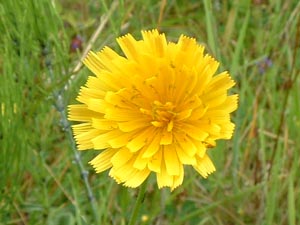
July 26th
This
Sneezewort is said to make you sneeze if you sniff it. I didn't identify it
until I got home, but I'll try next time I see it.
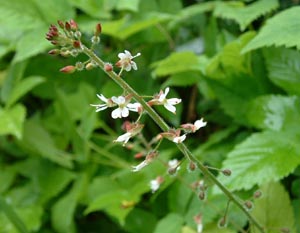
This is Enchanters Nightshade - what a beautiful name.
Another new
one for me, the Red Bartsia - a member of the Figwort family
These are the seeds of the Goosegrass. Like all other parts of the plant, they're covered in hooks for dispersal.
The seed
pods of the Bush Vetch have matured, now.
This Sawfly was very active. Note the white stripes on the
antennae.
27th July
This is the 5th Hypericum on the Hedgerow - the Perforate St. Johns Wort.
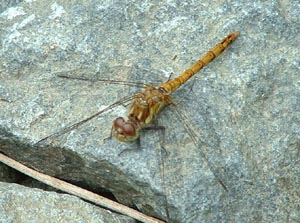
This Dragonfly was kind enough to stop very briefly - it was hot and they were very active.
I'm pretty sure it's a female Common Darter.
There were a lot of these yellow mushrooms growing on old cow
dung.
28th July
It was very wet,
today, and these two mushrooms shone brightly.
Two more escapes. On the left, Montbretia, on the right the enormous (12' tall) Japanese Knot Weed
This is a better picture of the Perforate St. John's Wort.
29th July
Torrential downpour, today. Roads flooded...
This is the Snowberry, now turned white:
This next
picture takes a bit of looking at. At first glance, we see the seedhead of the
Cow Parsley. But look again at the 'South West' branch (The silvery one). It's
actually the grub of some insect posing as part of the plant to avoid detection.
It didn't fool me.
And here's a moth posing as a piece of dead vegetation (easy to see on a green leaf, but just imagine it on a piece of bark, or on dead leaves)
Here's
another Drone Fly, this time on the Bramble flower:
It's clearly Fungus time, again. I see new ones every day.
30th July
Just a quick visit between showers, today. I think this is a Liverwort - it was growing on a wet part of the path.
This is a Blowfly, otherwise known as the Blue-bottle.
Yet another fly, species unknown.
31st July
The
Bilbery has gone black. Now we just need to wait for it to swell a bit.
This spider was just hanging on its web
Now you can see how the Birds Foot Trefoil got its name. This is the seedhead.
Back to Home page Back to June - Part 3 Feedback Annexe Map News